Granite Formation
The word granite comes from the Latin granum, a grain, in reference to the coarse-grained structure of such a crystalline rock.
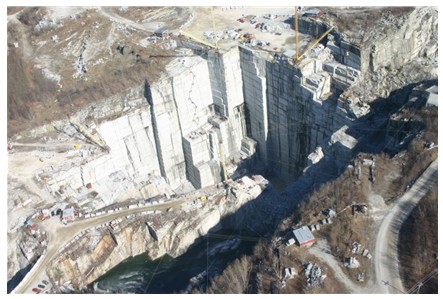
Granite Quarry
Granite is a coarse-grained rock found in plutons, large, deep-seated bodies of rock that slowly cooled from the molten state. It is the typical plutonic rock. Granite is thought to form as hot fluids from deeper in the mantle rise and trigger widespread melting in the continental crust. Continents are relatively hot because they contain most of the planet's uranium and potassium, which heat up their surroundings through radioactive decay.
The immediate cause of granite collecting and rising in huge stocks and batholiths is thought to be the stretching apart, or extension, of a continent during plate tectonics. This explains how such large volumes of granite can enter the upper crust without exploding, shoving or melting their way upward. And it explains why the activity at the edges of plutons appears to be generally gentle and why their cooling is so slow.
On the grandest scale, granite represents the way the continents maintain themselves. The minerals in granitic rocks break down into clay and sand and are carried to the sea. Plate tectonics returns these materials through seafloor spreading and subduction, sweeping them beneath the edges of the continents. There they are rendered back into feldspar and quartz, ready to rise again when and where the conditions are right.
Granite is a common and widely occurring type of intrusive, felsic, igneous rock. Granites usually have a medium to coarse grained texture. Occasionally some individual crystals are larger than the groundmass in which case the texture is known as porphyritic. A granitic rock with a porphyritic texture is sometimes known as a porphyry. Granites can be pink to dark gray or even black, depending on their chemistry and mineralogy.
Granite is the signature rock of the continents. Granite is the signature rock of the planet Earth itself. The other rocky planets, Mercury, Venus and Mars, are covered with basalt, as is the ocean floor on Earth. But only Earth has this beautiful and interesting rock type in abundance.
The different Types of “Granite”
First, granite is made of large mineral grains that fit tightly together, which is where its name came from.
Second, granite always consists of the minerals quartz and feldspar, with or without a wide variety of other minerals. The quartz and feldspar generally give granite a light color, ranging from pinkish to white. But that light background color is punctuated by the darker accessory minerals. Thus classic granite has a "salt-and-pepper" look. The most common accessory minerals are the black mica biotite and the black amphibole hornblende.
Third, almost all granite is igneous meaning it solidified from a fluid state and plutonic meaning that it did so in a large, deeply buried body or pluton. The random arrangement of grains in granite is evidence of its plutonic origin. Rock with the same composition as granite can form through long and intense metamorphism of sedimentary rocks. But that kind of rock has a strong fabric and is usually called granite gneiss.
With only a little practice, you can easily tell this kind of rock in the field. A light-colored, coarse-grained rock with a random arrangement of minerals—that's what most of us mean by "granite." Ordinary people, but that's not real granite.
Geologists are professional students of rocks, and what you would call granite they call granitoid. True granite is only one of the granitoids, a granitoid with quartz content between 20 and 60 percent and a feldspar content in which alkali feldspar rather than plagioclase feldspar predominates.
Stone dealers have another set of criteria for granite. Granite is a strong stone because its mineral grains have grown tightly together during a very slow cooling period. And the quartz and feldspar that compose it are harder than steel. This makes granite desirable for buildings and for ornamental purposes such as gravestones and kitchen worktops. Granite takes a good polish and resists weathering and acid rain. But stone dealers use "granite" to refer to any rock with big grains and hard minerals. So many types of “granites” seen in buildings and showrooms don't match the geologist's definition. Black gabbro or peridotite, or streaky gneiss, which even amateurs would never call "granite" in the field, still qualify as granite in a kitchen worktop or building Trade.
True Granite
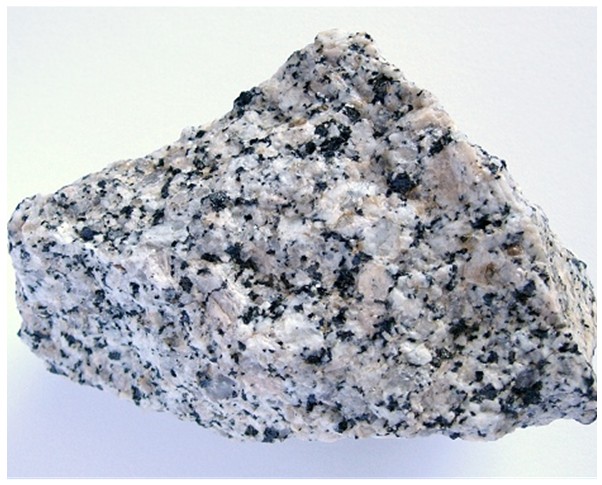
Granite of the Salinian block, consisting of plagioclase feldspar (white), alkali feldspar (buff), quartz, biotite and hornblende.
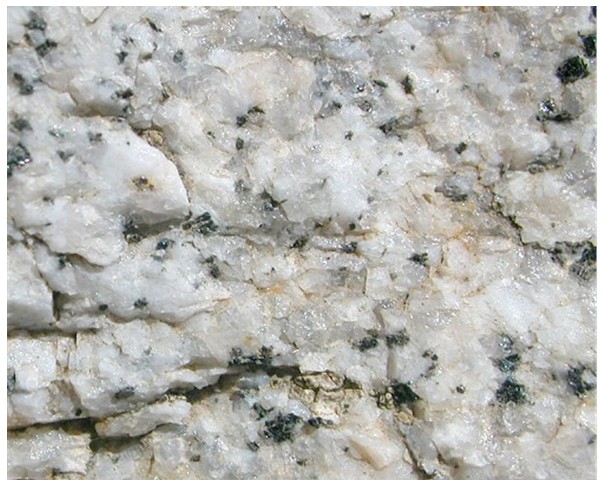
Close up of the white granite of the Salinian block
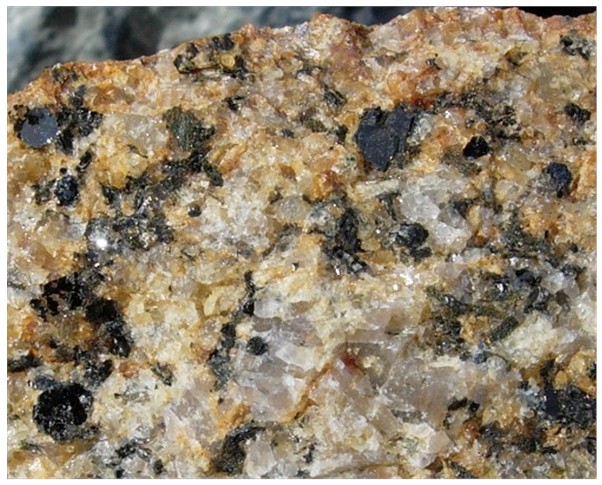
Granite of the Sierra Nevada, consisting of quartz, feldspar, biotite and hornblende.
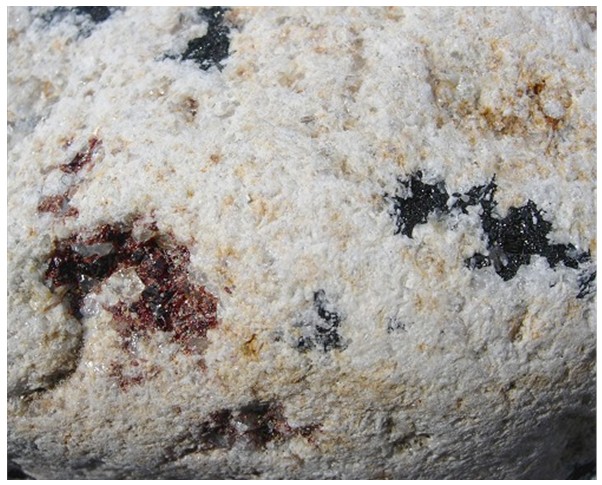
Close up of the Sierra Nevada Granite, consisting of feldspar, quartz, garnet (left) and hornblende (right).
A Couple of examples
.jpg)
Giallo Veneziano from Brazil
Description of Giallo Veneziano: A medium to coarse-grained, ochre-yellow to golden-brown, also light pink gneiss of the Precambrian period, with biotite and garnet, Italian (giallo meaning yellow). This stone internationally may be nominated as a Granite however in the area of application of the European Standard (EN) this stone must be nominated as gneiss.
Gneiss ("nice") is a rock of great variety with large mineral grains arranged in wide bands. It means a type of rock texture, not a composition.
Gneiss is a high grade metamorphic rock. This means that gneiss has been subjected to more heat and pressure than schist. (The schists form a group of medium-grade metamorphic rocks). Gneiss is coarser than schist and has distinct banding. This banding has alternating layers that are composed of different minerals. The minerals that compose gneiss are the same as granite. Feldspar is the most important mineral that makes up gneiss along with mica and quartz. Gneiss can be formed from a sedimentary rock such as sandstone or shale, or it can be formed from the metamorphism of the igneouse rock grantite. Gneiss can be used by man as Kitchen worktops, tiles, paving and building stone.
Metamorphic rocks are those that form by the effects of heat, pressure and shear upon igneous and sedimentary rocks.
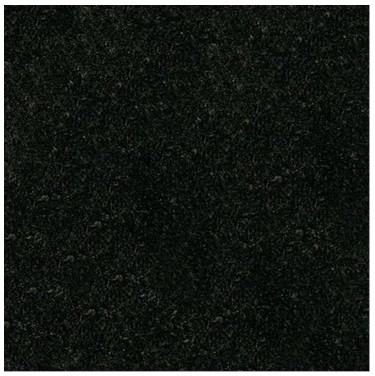
Nero Assoluto from India
Description - A fine to medium-grained black basalt dolerite. Nero Assoluto is also a black Gabbro from Zimbabwe. This stone internationally may be nominated as a granite however in the area of application of the European Standard (EN) this stone must be nominated as dolerite. A fine to medium-grained, dark gray to black intrusive igneous rock. It is extremely hard and tough and is commonly quarried for crushed stone, under the name of trap. It makes an excellent monumental stone and is one of the dark-coloured rocks commercially known as black granite.
Gabbro is a dark plutonic rock that is considered to be the plutonic equivalent of basalt. Unlike granite, gabbro is low in silica and has no quartz; also gabbro has no alkali feldspar, only plagioclase that often is dark with a high calcium content. Plagioclase tends to be more transparent than alkali feldspar; it also very commonly shows striations on its cleavage faces that are caused by multiple crystal twinning within grains.
Gabbro is named after a town in Tuscany, Italy. You can get away with calling almost any dark, coarse-grained igneous rock gabbro.
Why is all Black Granite called Nero Assoluto or Nero Absolute?
One common misunderstanding is that of all Nero Absolute black granites being the same material. They are not and they can vary widely in colour, quality and price!
Did you know that original Absolute Black, also known as Sutareboda, a Swedish black granite which has been quarried for many years.
The most famous Swedish black granite is Ebony Black. Ebony Black is very hard and durable, takes a beautiful polish and has an almost metallic "ringing" tone when struck with a hammer and chisel. Unfortunately, it is also very expensive! It is also known as Hallandia depending from which quarry it originates.
In 1962 Belfast Black granite from South Africa was first exported and shortly after this the trade in Italy started calling this granite Nero Assoluto, which literal means when translated Black Absolute. Alternative names have been South African Ebony, South African Black and Prairie and the less black qualities also a silver star reflector.
Since 1960's, Nero Assoluto has become the generic name for many black granites supplied from Italy, Angola, China, India, South Africa, Zimbabwe and many other countries, therefore unless one is specific the granite could actually be from anywhere!
Most of the Good suppliers that Granite companies purchase from buy Premium Black Granite either from India, Africa and Chinese Shanxi Black which top quality is lovely but really expensive, whether your Granite Company uses any one of these as Nero Assoluto they are lovely for Kitchen worktops.
Black Granite sometimes comes up with white ring marks or ring marks appear when wet, Absolute Granite Care has chemicals that can remove these. The ring marks appear because of chemicals used in the Quarrying and cutting into slabs process. It might only happen say a few in a block a block can consist of 30 to 40 slabs.
- Tile Cleaning
- Commercial Projects
- Marble Care
- Ask the Expert
- Contact Us
- Gallery Other
- How is marble formed
- The 7 secrets of Granite
- The 7 secrets of Tiles
- Customer Questions and Answers
- Granite/Quartz kitchen worktops
- Floor Care and Restoration
- Lithofin Shop
- Feedback
- LTP Care products
- Chip Repair In Manchester
- Privacy policy


